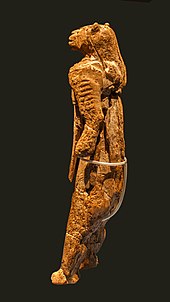
Back Leeumens Afrikaans الأسد الإنسان Arabic Krapolik (balumaks) AVK Aslan adam Azerbaijani Чалавекалеў Byelorussian Чалавекалеў BE-X-OLD সিংহ-মানব Bengali/Bangla Den leon Breton Humà lleó Catalan Lví muž Czech
The Löwenmensch figurine, also called the Lion-man of Hohlenstein-Stadel, is a prehistoric ivory sculpture discovered in Hohlenstein-Stadel, a German cave, part of the Caves and Ice Age Art in the Swabian Jura UNESCO World Heritage Site, in 1939. The German name, Löwenmensch, meaning "lion-person" or "lion-human", is used most frequently because it was discovered and is exhibited in Germany.
Determined by carbon dating of the layer in which it was found to be between 35,000 and 41,000 years old, it is one of the oldest-known examples of an artistic representation and the oldest confirmed statue ever discovered.[1] Its age associates it with the archaeological Aurignacian culture of the Upper Paleolithic.[2] An example of zoomorphic art, it was carved out of mammoth ivory using a flint stone knife. Seven parallel, transverse, carved gouges are on the left arm.
After several reconstructions that have incorporated newly found fragments, the figurine stands 31.1 cm (12.2 in) tall, 5.6 cm (2.2 in) wide, and 5.9 cm (2.3 in) thick. It is currently displayed in the Museum Ulm, in the town of Ulm.
- ^ "Lion man takes pride of place as oldest statue" by Rex Dalton, Nature 425, 7 (4 September 2003) doi:10.1038/425007a also Nature News 4 September 2003
- ^ "14C dating - The age of the lion man". loewenmensch.de (in German). Ulm, Germany: Museum Ulm.
© MMXXIII Rich X Search. We shall prevail. All rights reserved. Rich X Search

